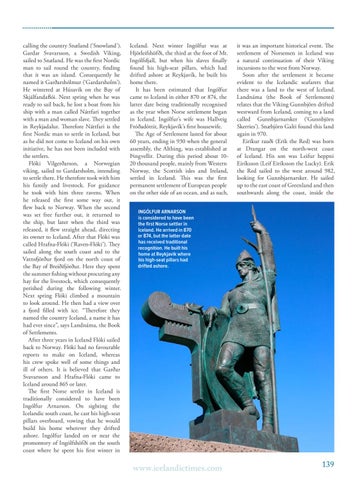calling the country Snæland (‘Snowland’). Gardar Svavarsson, a Swedish Viking, sailed to Snæland. He was the first Nordic man to sail round the country, finding that it was an island. Consequently he named it Garðarshólmur (‘Gardarsholm’). He wintered at Húsavik on the Bay of Skjálfandaflói. Next spring when he was ready to sail back, he lost a boat from his ship with a man called Náttfari together with a man and woman slave. They settled in Reykjadalur. Therefore Náttfari is the first Nordic man to settle in Iceland, but as he did not come to Iceland on his own initiative, he has not been included with the settlers. Flóki Vilgerðarson, a Norwegian viking, sailed to Gardarsholm, intending to settle there. He therefore took with him his family and livestock. For guidance he took with him three ravens. When he released the first some way out, it flew back to Norway. When the second was set free further out, it returned to the ship, but later when the third was released, it flew straight ahead, directing its owner to Iceland. After that Flóki was called Hrafna-Flóki (‘Raven-Flóki’). They sailed along the south coast and to the Vatnsfjörður fjord on the north coast of the Bay of Breiðifjörður. Here they spent the summer fishing without procuring any hay for the livestock, which consequently perished during the following winter. Next spring Flóki climbed a mountain to look around. He then had a view over a fjord filled with ice. “Therefore they named the country Iceland, a name it has had ever since”, says Landnáma, the Book of Settlements. After three years in Iceland Flóki sailed back to Norway. Flóki had no favourable reports to make on Iceland, whereas his crew spoke well of some things and ill of others. It is believed that Garðar Svavarsson and Hrafna-Flóki came to Iceland around 865 or later. The first Norse settler in Iceland is traditionally considered to have been Ingólfur Arnarson. On sighting the Icelandic south coast, he cast his high-seat pillars overboard, vowing that he would build his home wherever they drifted ashore. Ingólfur landed on or near the promontory of Ingólfshöfði on the south coast where he spent his first winter in
Iceland. Next winter Ingólfur was at Hjörleifshöfði, the third at the foot of Mt. Ingólfsfjall, but when his slaves finally found his high-seat pillars, which had drifted ashore at Reykjavík, he built his home there. It has been estimated that Ingólfur came to Iceland in either 870 or 874, the latter date being traditionally recognised as the year when Norse settlement began in Iceland. Ingólfur’s wife was Hallveig Fróðadóttir, Reykjavík’s first housewife. The Age of Settlement lasted for about 60 years, ending in 930 when the general assembly, the Althing, was established at Þingvellir. During this period about 1020 thousand people, mainly from Western Norway, the Scottish isles and Ireland, settled in Iceland. This was the first permanent settlement of European people on the other side of an ocean, and as such,
it was an important historical event. The settlement of Norsemen in Iceland was a natural continuation of their Viking incursions to the west from Norway. Soon after the settlement it became evident to the Icelandic seafarers that there was a land to the west of Iceland. Landnáma (the Book of Settlements) relates that the Viking Gunnbjörn drifted westward from Iceland, coming to a land called Gunnbjarnarsker (‘Gunnbjörn Skerries’). Snæbjörn Galti found this land again in 970. Eiríkur rauði (Erik the Red) was born at Drangar on the north-west coast of Iceland. His son was Leifur heppni Eiríksson (Leif Eiríksson the Lucky). Erik the Red sailed to the west around 982, looking for Gunnbjarnarsker. He sailed up to the east coast of Greenland and then southwards along the coast, inside the
INGÓLFUR ARNARSON is considered to have been the first Norse settler in Iceland. He arrived in 870 or 874, but the latter date has received traditional recognition. He built his home at Reykjavik where his high-seat pillars had drifted ashore.
www.icelandictimes.com
139
